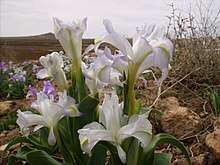Iris aucheri
Iris aucheri, the Aucher-Éloy iris, is a species of flowering plant in the family Iridaceae. It is a bulbous perennial in the Juno group of irises (multiple flowers per plant).
| Iris aucheri | |
|---|---|
 | |
 | |
| Scientific classification | |
| Kingdom: | Plantae |
| Clade: | Tracheophytes |
| Clade: | Angiosperms |
| Clade: | Monocots |
| Order: | Asparagales |
| Family: | Iridaceae |
| Genus: | Iris |
| Subgenus: | Iris subg. Scorpiris |
| Section: | Iris sect. Scorpiris |
| Species: | I. aucheri |
| Binomial name | |
| Iris aucheri | |
| Synonyms | |
|
Iris aucheri var. fumosa Bolt. | |
Description
Iris aucheri grows to 25 cm (10 in) tall, with crowded lanceolate (lance-shaped) leaves, producing several flowers in late winter or early spring.
The flowers may be white, pale blue or dark blue, with a yellow splash on the falls. It has a violet-like scent.
Biochemistry
As most irises are diploid, having two sets of chromosomes, this can be used to identify hybrids and classification of groupings.[2] It has a chromosomal count of 2n = 24.[3] A study in 2014, was carried out on various species of iris DNA, it found that I. iberica subsp. elegantissima had a purity value of 2.80, compared to 1.26 of Iris aucheri.
Taxonomy
The Latin specific epithet aucheri commemorates the 19th century French botanist Pierre Martin Rémi Aucher-Éloy.[4]
It was first described as Xiphion aucheri by Baker and then published as Iris aucheri by Sealy in Kew Bull. page 562 in 1950.[5][6]
There is a known variant Iris aucheri var. fumosa which was published in 2017.[7]
Distribution and habitat
It is native to temperate Western Asia.[5][8]
Cultivation
Iris aucheri is cultivated as an ornamental plant in gardens for its showy flowers. It requires neutral or slightly alkaline soil in a sheltered, frost-free spot, or it can be grown in an unheated greenhouse or conservatory, in the UK.[9][10]
It is hardy down to USDA Zone 6.[8] In the UK, it has been given a hardiness rating by the RHS of H4: −15 °C (5 °F) (hardy in most locations).[11]
This plant species has gained the Royal Horticultural Society's Award of Garden Merit.[11][12]
References
- "Iris aucheri". International Plant Names Index (IPNI). Retrieved 23 June 2013.
- Austin, Claire (2005). Irises; A Garden Encyclopedia. Timber Press. p. 18. ISBN 0881927309.
- Kamari, G.; Felber, F.; Garbari, F., eds. (1999). "Mediterranean chromosome number reports - 9" (PDF). Flora Mediterranea. 9. Retrieved 16 October 2015.
- Harrison, Lorraine (2012). RHS Latin for gardeners. United Kingdom: Mitchell Beazley. p. 224. ISBN 9781845337315.
- "Taxon: Iris aucheri (Baker) Sealy". npgsweb.ars-grin.gov. Retrieved 2 June 2020.
- "Iris aucheri | International Plant Names Index". www.ipni.org. Retrieved 2 June 2020.
- "Iris aucheri var. fumosa | International Plant Names Index". www.ipni.org. Retrieved 2 June 2020.
- "IRIS FLEUR-DE-LYS Iridaceae (Iris family)". www.hillkeep.ca. 12 May 2008. Retrieved 23 August 2014.
- RHS A-Z encyclopedia of garden plants. United Kingdom: Dorling Kindersley. 2008. p. 1136. ISBN 978-1405332965.
- "Juno irises A-I". Pacific Bulb Society. Retrieved 23 June 2013.
- "RHS Plant Selector - Iris aucheri". Retrieved 19 February 2020.
- "AGM Plants - Ornamental" (PDF). Royal Horticultural Society. July 2017. p. 53. Retrieved 13 March 2018.